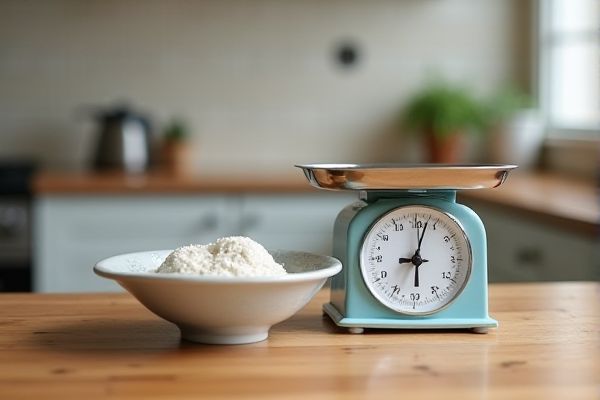
Digital kitchen scales offer precise measurements with easy-to-read displays and often include features like unit conversion and tare functions, making them ideal for accurate cooking and baking. Analog scales provide a mechanical, battery-free option with a classic design but may lack the precision of digital models; explore the full article to discover which kitchen scale best suits your culinary needs.
Table of Comparison
| Feature | Digital Kitchen Scale | Analog Kitchen Scale |
|---|---|---|
| Accuracy | High precision, measures in grams and ounces | Less precise, approximate measurements |
| Readability | Easy-to-read digital display | Dial with needle, harder to read exact weight |
| Units of Measurement | Multiple units: grams, ounces, pounds, milliliters | Usually pounds and ounces only |
| Power Source | Requires batteries or rechargeable power | Mechanical, no power needed |
| Durability | Electronic components sensitive to moisture | Robust, often metal construction |
| Price | Moderate to high cost | Generally lower cost |
| Additional Features | Tare function, auto-off, backlit display | Basic weighing only |
Introduction to Kitchen Scales
Kitchen scales come in two primary types: digital and analog, each offering unique benefits for precise measurement in cooking and baking. Digital kitchen scales provide highly accurate readings with easy-to-read displays and often include features such as unit conversion and tare function. Your choice between digital or analog scales can impact measurement accuracy, user convenience, and overall cooking efficiency.
What is a Digital Kitchen Scale?
A digital kitchen scale is an electronic device that measures the weight of ingredients with high precision, displaying results on an LCD or LED screen. It uses sensors such as strain gauges to convert the physical weight into an electronic signal, ensuring accurate and consistent measurements essential for cooking and baking. Digital kitchen scales often feature tare functions, multiple unit options, and easy-to-read displays, making them a preferred tool for precise ingredient portioning.
What is an Analog Kitchen Scale?
An analog kitchen scale measures weight using a spring mechanism connected to a dial display, providing readings through a needle that points to corresponding weight markings. Unlike digital scales that offer precise numerical values, analog models rely on mechanical components and may require manual calibration for accuracy. Your choice between analog and digital depends on preferences for simplicity, durability, and the level of precision needed in kitchen measurements.
Accuracy and Precision: Digital vs Analog
Digital kitchen scales provide superior accuracy and precision by displaying exact measurements, often down to grams or ounces, ensuring consistent results for cooking and baking. Analog scales rely on mechanical springs and dial readings, which can be less precise due to potential calibration drift and difficulty in reading small increments. Your best choice for reliable, repeatable measurement is a digital scale, especially when exact portion control is crucial.
Ease of Use and Readability
Digital kitchen scales provide clear, easy-to-read LCD displays that show precise measurements, making them user-friendly for quick and accurate portioning. Analog scales rely on a dial with a needle, which can sometimes be difficult to read precisely, especially for small increments. Your choice may depend on whether you prioritize instant readability and exact figures or prefer a more traditional, manual option.
Features and Functionality Comparison
Digital kitchen scales offer precise measurements with features like tare function, unit conversion, and digital display for easy reading. Analog scales provide a mechanical dial for measurement, typically without advanced features, making them simpler but less accurate. Digital scales often include additional functionalities such as memory storage, nutritional information tracking, and auto-off, enhancing usability in modern kitchens.
Durability and Maintenance
Digital kitchen scales often feature durable materials such as stainless steel and tempered glass, offering resistance to corrosion and easy cleaning, while their electronic components may require careful handling to avoid damage. Analog kitchen scales, built with mechanical parts and metal casings, tend to be more robust against drops and moisture but may need regular calibration and parts replacement for consistent accuracy. Maintenance for digital scales typically involves battery replacement and keeping sensors dry, whereas analog scales benefit from occasional lubrication and mechanical inspection.
Price Comparison: Value for Money
Digital kitchen scales generally offer more precise measurements and additional features like tare functions and unit conversions, often priced between $15 and $50. Analog kitchen scales, with simpler mechanical designs, typically range from $10 to $30 but may lack accuracy and versatility. Evaluating value for money depends on prioritizing precision and convenience, where digital scales usually provide stronger long-term benefits despite a slightly higher initial cost.
Which Scale is Better for Home Cooking?
Digital kitchen scales offer precise measurements with easy-to-read displays, ideal for baking and portion control in home cooking. Analog scales provide durability and no batteries required but can be less accurate and harder to read, which may affect recipe consistency. For most home cooks, a digital scale is better due to its accuracy, convenience, and ability to switch between measurement units instantly.
Conclusion: Choosing the Right Kitchen Scale
Choosing the right kitchen scale depends on your precision needs and cooking habits. Digital kitchen scales offer higher accuracy and easy-to-read displays, making them ideal for precise measurements and recipes. Analog scales provide durability and simplicity without needing batteries, suiting those who prefer a straightforward, mechanical option in their kitchen.
 homyna.com
homyna.com